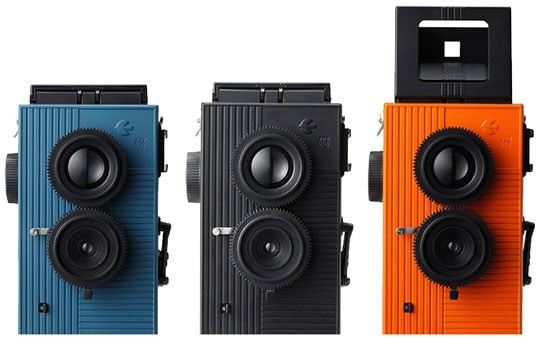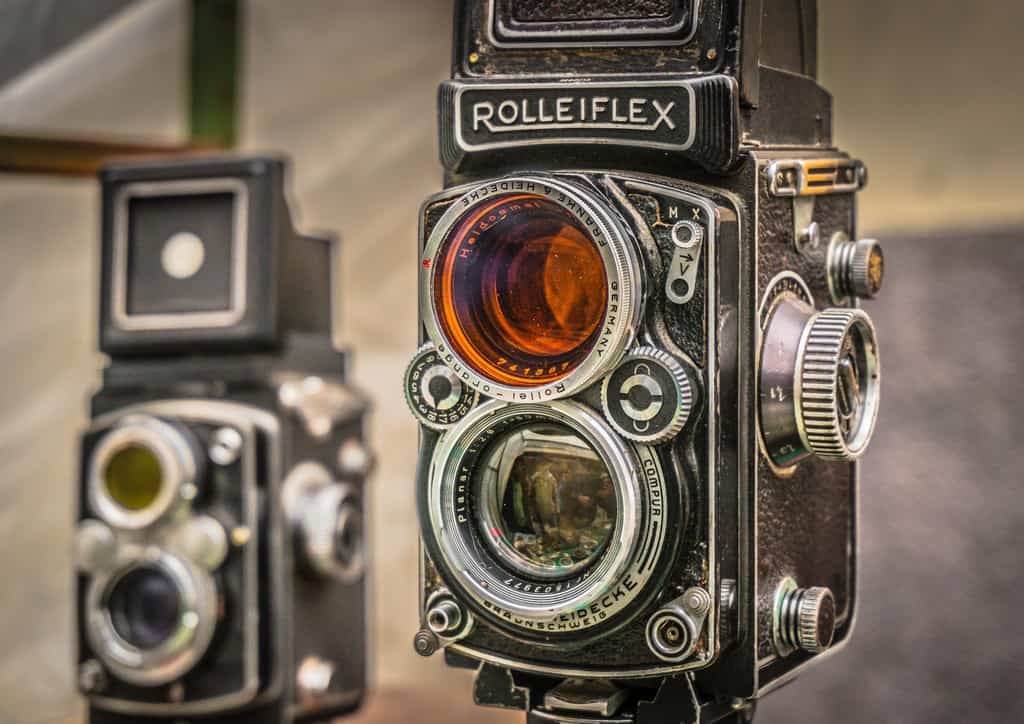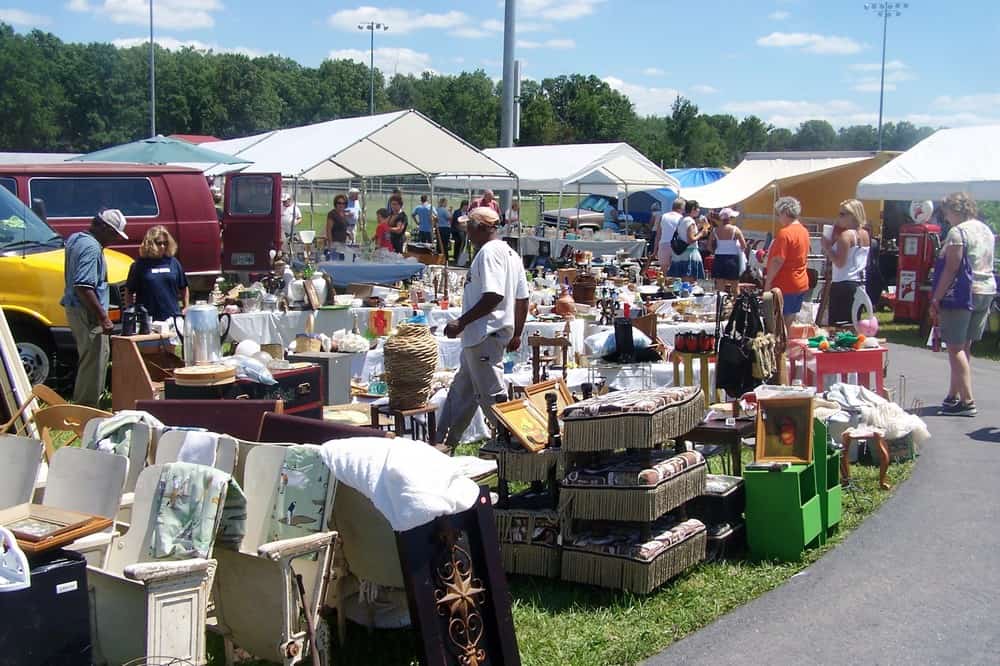Six month ago I was walking down a street in Brooklyn, and stopped by the window of a so-called “design” shop that was selling “must-have” stuff to decorate one’s home. While I was browsing from outside the content of the shop, my eyes were drawn to three small colored objects standing on a shelf. I went into the shop and got closer to that shelf; to my surprise, I realized that these candy-like-colored blue, red and green boxes were actually cameras! Twin Lens Reflex to be accurate.

–> Warning: image is meant to illustrate the above text. Please, never buy this piece of crap. <–
Well, they said they were. After having a closer look at one of them, I realized they only were VERY cheap copies of a Lubitel (and Lubitel is already a cheap TLR; so try and picture what a cheap-cheap TLR might look like… Yep, like something CHEAP): they were made of plastic, plastic and plastic. Well, not exactly all plastic, as there were some screws to keep all that plastic together in one piece and the lenses were made of glass (well, I’m not even sure of that…). And to add insult to injuries, these cameras were operating a 35mm films (to my own opinion, a TLR should only operate a 120 film: these “square” pictures you never get with a 35mm are to me what make the specificity of a TLR camera).
To summarize it, just a piece of crap priced $90. Yes, that’s correct: $90.
why would some people spend $90 to buy a TLR-like plastic camera to look cool, when they could get a real one for only a few buck and actually BE cool?
I don’t understand that.
Flea markets & garage sales: the best places to find TLR cameras
Brooklyn is way one of the coolest places in NYC these days: everything there is about fashion, coolness and vintage. There are even some people who just seem to have been teleported a few seconds ago from the 70s. I love that.
Most people there don’t pretend. They just are. No fake, just real good old stuff. And I guess it would give you more of a headache to try and find new clothe to dress like in the 70s, 60s, 50s or even 40s than to find actual stuff from that era! The Brooklyn Flea Market, The Garage, The Hell’s Kitchen flea market are among other places where you can really find cool and genuine vintage clothing for a few bucks.
And that also applies to cameras.

cameras at flea market buenos aires, Feria de San Telmo , San Telmo Flea Market
I challenge anyone reading this post, to give me the name of any place which deserves to be referenced as “flea market”, where they won’t be able to find for less than $50 one of these toy camera or medium format/TLR camera that seem to have gained a new interest among the hipsters. I’ve tried, and did not succeed.
My very own experience with TLR cameras
During my two weeks trip to NYC, I found hundreds of them. I eventually purchased three TLRs (models I had never seen before or never thought I would ever find sitting on a flea market booth), and brought them back to Europe; so far I’ve tried and benchmarked two of the three cameras I found (the other one needs 620 films and I did not have time to re-spool a 120 film on a 620 spool) and I have to say that I’m very satisfied with the purchase I made, particularly regarding the Mamiya C330: it renders an awesome image quality in comparison with the Rolleiflex T model or Yashica Mat. 124G I regularly use. Though it is “quite” bulky, I’m fine with carrying it everywhere with me as it just takes great pictures. And let me tell you that it makes quite an impression on people around me! They just love it!
Just keep in mind something: whatever is your intention behind acquiring a TLR camera (should it be because you want to discover the pleasure of analog photography in an “old fashion” way, or because you want to have something cool and genuine to carry with you anywhere you go or to give a flavour to your living room), you will eventually find your IDEAL TLR camera. It’s just a matter of time and being an early bird at the flea market. And whatever the price you pay for it, as long as you intimately, in the deep of your heart, believe that THIS IS THE ONE, then, it’s a great purchase.
I now have a dozen of TLR cameras, all from different manufacturers, and I pick them, just like anyone would pick his own outfit in the morning: depends on the weather, depends on my mood or my inspiration. Sometimes I like to pick my inaccurate Lubitel 2 (Lomo) because it’s just beautifully simple and because it reminds me of a great trip I once did to Venice.
My Rolleiflex T is to me, what a 1965 Shelby 289 Cobra is to a classic car lover: just the pure pleasure of the shape of the “beast” and the melody of the mechanics.
And when I leave home with my Mamiya C330 in my backpack, I’m confident that I’ll “put in the box” something worth it, something of pure inspiration.
And that is the other pleasure of taking photos with an analog camera: you live for days with the exhilaration of this feeling of “anything is possible”, until you finally get your negative revealed; and this feeling, is priceless.
7 reasons why you should buy a genuine TLR camera
- Genuine TLR cameras & toys cameras can be found in almost any flea market: Lubitel, Rolleicord, Diana, Kodak Brownie, Anscoflex, Voightlanders, Agfa Anastigmat camera, Mamiya, Bronica (and even a Hasselblad or Rolleiflex if you’re lucky…). You’ll be able to start your own collection if you’re patient enough and willing to spend $10-$20 every time you find one of these.
- Most old TLR cameras & toy cameras still work perfectly nowadays. Most of them use 120 films that can be found and processed almost anywhere. There are even a wide variety of professional films that can be used in these cameras: my favorites are the Kodak Ektar 100, Kodak 160 VC and NC, Kodak 400 VC and NC, or any Fuji films in 100, 160 or 400 asa/iso). You can easily find them on www.bhphotovideo.com/ or eBay. For 620 films like in the Ascoflex, you can always re-spool a 120 film on a 620 spool (same width).
- All TLR cameras & toys cameras perform better than the new ones you’ll find in these so called “design store” and that will cost you up to a hundred bucks (or even more: at the Metropolitan Museum of Art in New York I found a new edition of a Lubitel 166 for… $350! Please, give me a break). Also, I’ve noticed that these “would-be” TLR cameras made of plastic use 35mm films (be aware that they’re no middle format camera!)
- TLR cameras & toys cameras are just GREAT to operate and to carry anywhere. While in NYC, I eventually had to leave my Rolleiflex in my backpack as every hundred meters someone stopped me to ask about this strange camera or congratulate me for reviving the TLR spirit. TLR cameras are real “social boosters”.
- Last but not least: you’ll be amazed by the fun (and quality, depending on what TLR you choose) of taking pictures with TLR & Toy cameras bring. The fun I had of taking picture disappeared the day I realized that it was my digital camera which was actually making great pictures, not me. It also made me lazier (With digital camera you can shoot anything, without having to care about what it will cost to have the pictures processed. When you have a 12 exposures film, you think it twice before shooting three times the same boring scene.
- You will learn (or re-discover) photography: before I started using TLR & toy cameras, I had no idea of how to deal with my digital camera’s “aperture” and “shutter speed”. Actually I never had to bother with that as I was using 80% of my time the Automatic mode. I learned photography techniques using a good old Lubitel 2. And I bet you’ll enjoy that too.
- And finally, you will discover with TLR this new feeling of “bending with humility” when you take your photo: you don’t aim at your subject like a sharpshooter, and “push” the trigger; you hold your camera close to your stomach like it’s a part of you, watch the world like in a mirror, discover a new reality your eyes don’t see on their own; and this physical distance between your eyes and the lens viewer of the camera, gives you the feeling of watching a motion picture you’re somehow directing. Pure pleasure.


